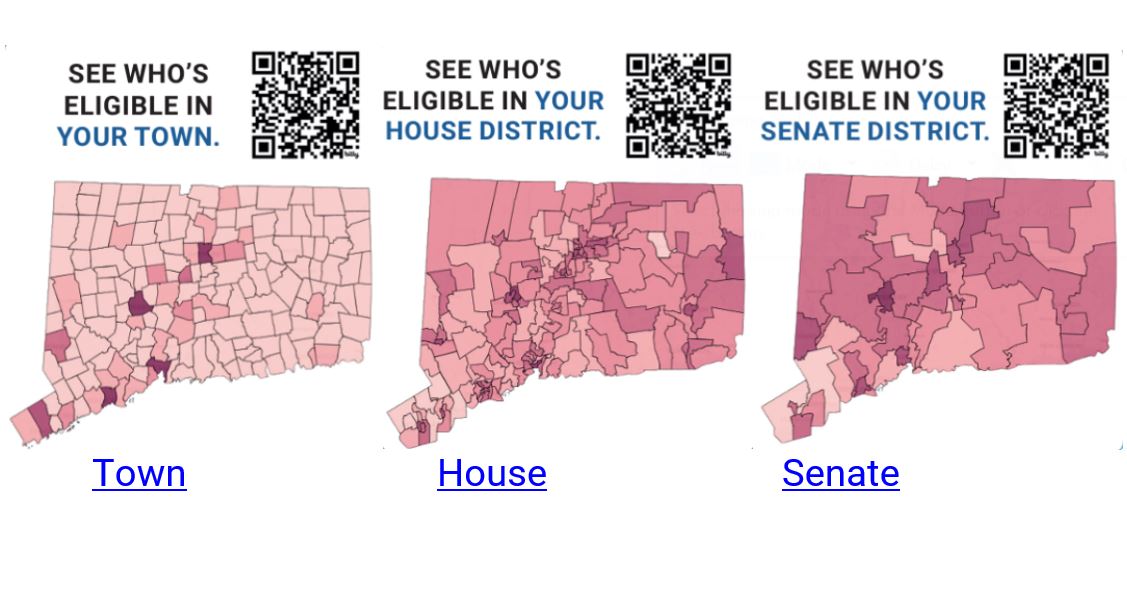All DataHaven Programs, Economy
United Way of Connecticut and DataHaven Maps Show Potential Impact of a Proposed CT Child Tax Credit on Local Communities
New maps show that 268,000 eligible families statewide would receive $306 million in total tax credits, benefiting 75 percent of all Connecticut families.
Rocky Hill, CT (March 18, 2024) – United Way of Connecticut in partnership with DataHaven released three interactive online maps that show the distribution of the proposed Child Tax Credit across the state and illustrate the impact it could have on financial security, racial equity and economic prosperity. The maps show impact by town and by House and Senate districts.
The proposed CT Child Tax Credit:
• Allocates $600 per child annually, for up to three children per filing family.
• Assumes a population of single-filing families making less than $100,000 per year, and joint-filers making less than $200,000 per year, eligible to receive the credit.
• Includes stipulation that the credit would be fully refundable, meaning that families without tax liability would receive the full value of the tax credit as a refund.
Using counts of eligible families from the 2018-2022 U.S. Census American Community Survey, the maps show that 75% of families with children would receive crucial support, including 91% of Connecticut’s Latino families and 88% of Black families.
From July to December 2021, an enhanced federal Child Tax Credit provided advance payments to nearly all U.S. families with dependent children each month.
According to Mark Abraham, Executive Director of DataHaven, “The enhanced federal credit is widely considered to have had a significant impact in reducing child poverty across the nation — it led, in particular, to a large drop in food insecurity among families with children, nationally and in Connecticut. The enhanced federal Credit lifted 33,000 Connecticut children out of poverty in 2021. But that enhanced credit has now expired. For all these reasons, we believe that a CT Child Tax Credit would have measurable impacts on family economic well-being as well, assuming that it was of sufficient scale and reach.”
“More than half a million households in Connecticut struggle to make ends meet — 67% of those households (371,207) are families with children,” says Lisa Tepper Bates, President and CEO of United Way of Connecticut. “Plus, we’re the only state that taxes family income without offering tax relief for raising children. A Connecticut Child Tax Credit would empower families to afford essentials and access opportunities that otherwise may be beyond their reach.”
The partners in the Connecticut Nonprofit Child Tax Credit Coalition cite Moody’s Analytics estimate that every dollar of Child Tax Credit results in $1.38 of economic activity, yielding a 38% return on the investment that contributes to a thriving community.
Click here to read the full report from DataHaven.
###
Media Contact: Carin Buckman, United Way of Connecticut, Carin.Buckman (at) ctunitedway.org, 860-249-1950
ABOUT UNITED WAY OF CONNECTICUT
The mission of United Way of Connecticut is to help Connecticut residents thrive through trusted partnerships and innovative solutions. United Way of Connecticut is recognized by the Hartford Business Journal as a 2023 Best Workplace in Connecticut. Learn more at ctunitedway.org. Visit the United Way media center for media requests and inquiries.
ABOUT DATAHAVEN
DataHaven’s mission is to empower people to create thriving communities by collecting and ensuring access to data on well-being, equity, and quality of life. They have served Connecticut as a nonprofit organization since 1992, working with many partners to develop reports, tools, and technical assistance programs that make information more useful to local communities. DataHaven is a partner of the National Neighborhood Indicators Partnership, a learning network, coordinated by the Urban Institute of independent organizations in 30 cities that share a mission to ensure all communities have access to data and the skills to use information to advance equity and well-being across neighborhoods. They are also involved in initiatives to further the use of high-quality data at a local and statewide level throughout Connecticut.

